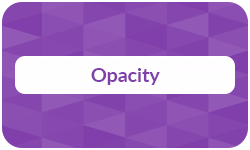
Among the many important printing terms, opacity plays a crucial role in making your printed content look professional and easy to read. In printing, opacity describes how much light passes through a sheet of printer paper. Whether you’re printing double-sided documents, brochures, or academic papers, understanding opacity helps you choose the right materials for the best visual results.
Definition: Opacity
In printing, opacity describes the degree to which paper or other printed material prevents light from passing through it. Simply put, the more opaque a sheet is, the less you can see what’s printed on the other side.
For example, tracing paper has very low opacity, so text or images easily show through. In contrast, thick cardstock has high opacity and blocks light almost completely, making it ideal for double-sided printing.

In other contexts
While opacity is an important printing term, it also has different meanings in other areas:
Outside technical fields, “opacity” can also be used metaphorically to describe something unclear or difficult to understand, like an opaque explanation or a confusing process.
In graphic design, web development, and user interface (UI) design, opacity describes how transparent an element appears on a screen. For example, an image with 50% opacity will look faded because it is half transparent. In CSS, you can adjust opacity to layer visual elements or create visual effects.
In scientific fields, opacity can refer to how much a material absorbs or scatters light, heat, or radiation. For instance, astrophysicists discuss the opacity of gases in a star when studying how energy moves through it.
➜ Even though the core idea, how much something blocks what’s behind it, stays the same, the exact meaning of opacity depends on the context.
Note: This article focuses specifically on the meaning of opacity in printing. If you’d like to explore how opacity applies to areas, we recommend consulting dedicated resources on those topics.
Online A4 printing for AU$0.16
- Quick production times & reputable delivery
- Professional A4 prints for personal and business use
- Configure the printing specifications for your A4-size prints
Learn more!
Measuring in printing
In printing, opacity is measured as a percentage that indicates how well paper prevents light from passing through. The higher the percentage, the opaquer the paper is, and the less show-through you will see from the other side.
How opacity is quantified
Opacity is typically expressed on a scale from 0% to 100%, where:
0% opacity
The sheet is completely transparent.
100% opacity
No light passes through at all.
➜ Most standard office papers have opacity ratings between 85% and 95%, while specialty papers for high-end printing can reach even higher values.
Measuring tools & methods
To determine opacity, manufacturers and print professionals use specialized devices such as:
- Opacity meters
- Contrast ratio testers
These instruments measure how much light reflects from a sheet placed over a black background compared to a white background. The ratio of these two measurements produces the final opacity percentage.
Typical opacity ratings
Here are some examples of common printer paper types and their approximate opacity values:
Tracing paper
~30–40%
Premium laser paper
~90–95%
Standard copy paper (80 g/m²)
~85–88%
Thick cover stock or cardstock
~96–99%
Choosing the right opacity level helps ensure your printed materials look clean and professional. Especially when you print on both sides of a sheet.
Why it matters
Opacity has a direct impact on how professional and legible printed materials look. If the paper doesn’t block enough light, it can cause problems that reduce the overall quality and readability of your work.
Even if your design and layout are flawless, using paper with low opacity can make a document printing look cheap or unprofessional. High-opacity paper, on the other hand, feels substantial and helps colors and text stand out clearly without interference.
When printing on both sides of a sheet, like in book printing, report printing, or dissertation printing, low opacity allows text and images from the reverse side to show through. This is called show-through or ghosting, and it can make your content harder to read and visually distracting.
For academic projects like theses, dissertations, or research papers, clean presentation is essential. Many universities have specific guidelines recommending high-opacity paper to prevent show-through and maintain a polished appearance. Similarly, in professional projects such as letterhead printing, proposal printing, or resume printing, high-opacity paper creates a premium impression and ensures your message is easy to read.
➜ Choosing the right opacity level is a simple but crucial step in producing documents that meet high standards of quality and readability.
Factors affecting opacity
Several characteristics of paper and print influence how opaque the final product will be. Understanding these factors helps you choose materials that best suit your project’s requirements:

Paper color & fillers
Papers that contain added fillers or pigments (such as titanium dioxide) are more effective at preventing light transmission. Bright white paper often has higher opacity than natural or cream-coloured stock.

Printing inks & coverage
Large solid areas of dark printing ink can increase the perceived opacity of the paper by masking what’s behind it. Conversely, light ink coverage or minimal printing may make show-through more noticeable, especially on thinner sheets.

Coatings (matte or gloss)
Surface coatings can affect how light interacts with paper. Gloss-coated paper may reflect more light, but it doesn’t necessarily improve opacity. Matte coatings can help diffuse light slightly, reducing show-through.

Paper thickness & basic weight
Thicker paper or paper with a higher basis weight generally has higher opacity because it blocks more light. Similarly, paper weight can affect opacity. For example, heavyweight cardstock is much more opaque than lightweight copy paper.
High-quality color copies from just AU$0.28
- Choose from different paper formats & paper weights
- Configure finishing options & add any extras you need
- Easy online ordering process with delivery to your doorstep
Learn more!
Opacity vs. transparency
The terms opacity and transparency are closely related but describe opposite concepts:
This refers to how much light a material blocks. The higher the opacity, the less you can see through it. In printing, high-opacity paper prevents show-through and ensures text and images stay clear and legible.
This, on the other hand, describes how much light passes through a material. The more transparent something is, the easier it is to see what’s behind it, like tracing paper or clear plastic sheets.
Put simply:
✅ Opacity = how much light is blocked
✅ Transparency = how much light gets through
Understanding this difference is important when selecting paper and designing printed materials. High opacity is usually preferred for professional documents, while transparency is used intentionally for overlays, design effects, or special applications.

Examples
Here are examples to show how opacity affects printed materials:
Relevant standards
Different industries and academic institutions often have specific requirements for opacity. Many universities recommend using paper with at least 90% opacity for academic submissions to ensure that printed text and images on the reverse side don’t cause distracting show-through. In the commercial printing sector, brochures, business cards, and books are typically printed on high-opacity paper to maintain a professional appearance.
Paper certifications like the FSC (Forest Stewardship Council) may also provide guidelines on opacity levels, ensuring that the paper meets environmental and quality standards.
FAQs
Opacity describes how much light a material blocks. In printing, it refers to how well paper prevents text or images from the reverse side from showing through.
100% opacity means the paper is completely opaque, with no light passing through. Nothing printed on the other side will be visible.
A paper with 5% opacity is nearly transparent. You would clearly see any text or images behind it, similar to tracing paper.
For most printing, higher opacity is better because it prevents show-through and keeps the content clear and professional.
No, higher opacity means less transparent. The higher the opacity, the more the material blocks light.
- Opacity measures how much light is blocked.
- Transparency measures how much light passes through.
➜ High opacity = Low transparency